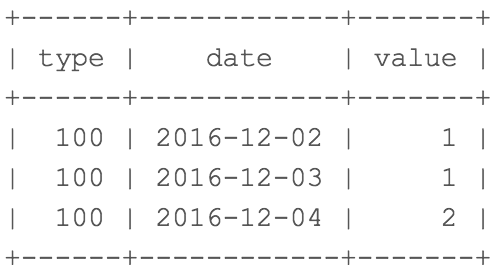Given a table containing a date for every day over a period
CREATE TABLE `tbl_calendar` (
`date` date NOT NULL,
PRIMARY KEY (`date`)
) ENGINE=InnoDB DEFAULT CHARSET=utf8 COLLATE=utf8_unicode_ci;
INSERT INTO `tbl_calendar` (`date`)
VALUES
('2016-12-10'),
('2016-12-09'),
('2016-12-08'),
('2016-12-07'),
('2016-12-06'),
('2016-12-05'),
('2016-12-04'),
('2016-12-03'),
('2016-12-02'),
('2016-12-01')
;
And a table containing values, of different types, with values missing for random days where they have not been populated.
CREATE TABLE `tbl_values` (
`value_id` int(11) NOT NULL AUTO_INCREMENT,
`type_id` int(11) NOT NULL DEFAULT '0',
`date` date DEFAULT NULL,
`value` double(15,2) DEFAULT '0.00',
PRIMARY KEY (`value_id`),
KEY `type_id_date` (`type_id`,`date`)
) ENGINE=InnoDB AUTO_INCREMENT=1 DEFAULT CHARSET=utf8 COLLATE=utf8_unicode_ci;
INSERT INTO `tbl_values` (`type_id`, `date`, `value`)
VALUES
(100, '2016-12-02', 1),
(100, '2016-12-04', 2),
(100, '2016-12-06', 3),
(100, '2016-12-08', 4),
(100, '2016-12-10', 5)
;
How can the values for the missing days be returned in a SELECT, using the most recent previous record for that type? here is what I have so far.
SELECT
v1.type,
c.date,
v1.value
FROM
tbl_calendar c
LEFT JOIN tbl_values v1 ON (
v1.type_id = 100
AND v1.date <= c.date
)
LEFT JOIN tbl_values v2 ON (
v2.type_id = 100
AND v2.date < c.date
AND v2.date > o1.date
)
WHERE
v1.date = c.date
OR v2.date IS NULL
The problem with this query is that it returns the previous most recent records value when there is a value for that date, along with a record with the correct value.
Expected Output
a_vlad answer is correct in results, however poor on performance, which is expected.
SELECT
t1.date,
(SELECT v1.type_id FROM tbl_values v1 where v1.date <= t1.date ORDER BY v1.date desc limit 1) as `type`,
(SELECT v1.`value` FROM tbl_values v1 where v1.date <= t1.date ORDER BY v1.date desc limit 1) as `value`
FROM tbl_calendar t1
HAVING `type` IS NOT NULL
The final solution that I used was to use a_vlad query to create a summary table. However, it turned out not to increase performance of the system (as previously the missing values were filled in in a PHP loop, which worked out to be as fast)



